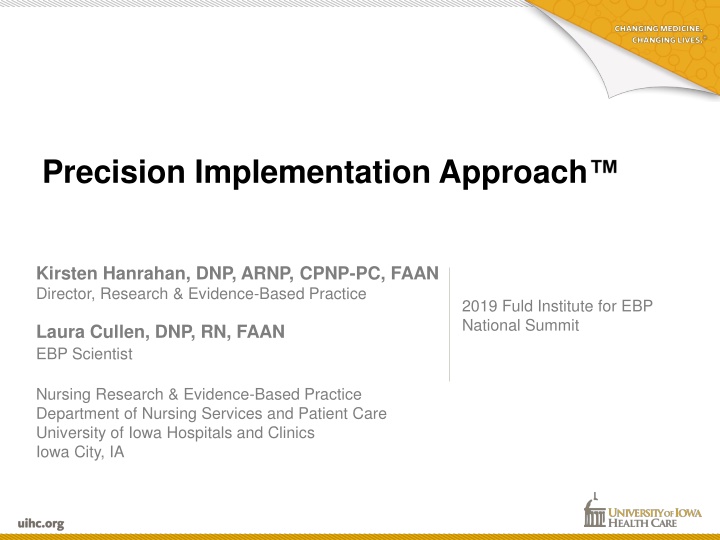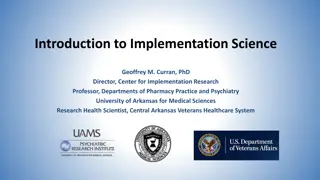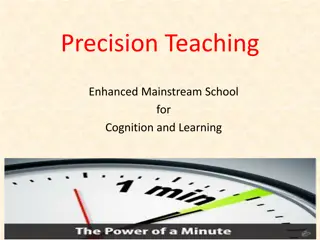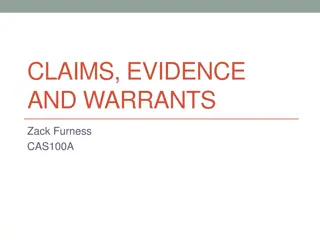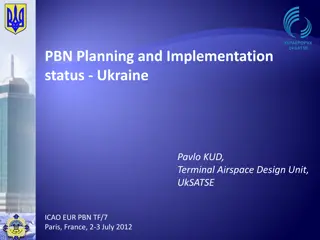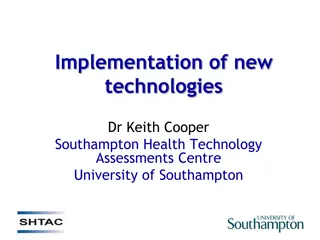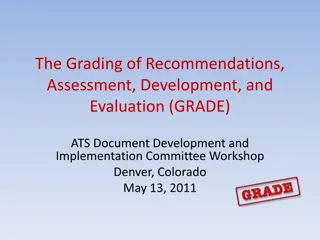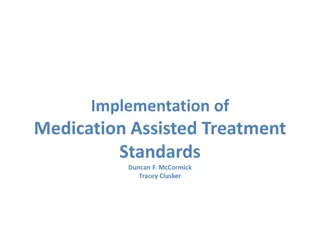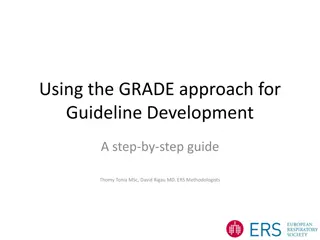Precision Implementation Approach in Evidence-Based Practice
Implementation is a complex step in Evidence-Based Practice (EBP) process with various strategies for effective and sustainable change. Utilizing local data-driven decisions, the Precision Implementation Approach selects accurate strategies for successful EBP outcomes. Linking process and outcome data is crucial for decision-making in improving outcomes. Evaluating EBP through a framework involving knowledge, practice, impact, and balancing measures ensures comprehensive assessment of interventions. Using local data to guide strategy selection enhances the efficacy of implementation efforts.
Download Presentation

Please find below an Image/Link to download the presentation.
The content on the website is provided AS IS for your information and personal use only. It may not be sold, licensed, or shared on other websites without obtaining consent from the author.If you encounter any issues during the download, it is possible that the publisher has removed the file from their server.
You are allowed to download the files provided on this website for personal or commercial use, subject to the condition that they are used lawfully. All files are the property of their respective owners.
The content on the website is provided AS IS for your information and personal use only. It may not be sold, licensed, or shared on other websites without obtaining consent from the author.
E N D
Presentation Transcript
Precision Implementation Approach Kirsten Hanrahan, DNP, ARNP, CPNP-PC, FAAN Director, Research & Evidence-Based Practice 2019 Fuld Institute for EBP National Summit Laura Cullen, DNP, RN, FAAN EBP Scientist Nursing Research & Evidence-Based Practice Department of Nursing Services and Patient Care University of Iowa Hospitals and Clinics Iowa City, IA 1
Implementation is among the most complex steps in the EBP process Many implementation strategies have been reported (~ 70) Cullen & Adams, 2012; Cullen et al., 2018; Powell et al., 2015 A phased approach helps the team plan for strategies that can be used over time Cullen & Adams, 2012; Levoy et al., 2019; Rogers, 2003; Wensing et al., 2010 Research supports the need to adapt the implementation plan to the context and address clinician and patient perceptions and behaviors Damschroder et al., 2009; Greenhalgh, 2018; Grol et al., 2013; Jager et al., 2016 Formative data are needed to decide when and how to effectively and efficiently use implementation strategies American Evaluation Association, 2012; Bick & Graham, 2010; Cullen et al., 2019; Parry et al., 2013; Russell et al., 2011
Link process and outcome data for decision making In order to change outcomes, we need to change processes. https://encrypted-tbn2.gstatic.com/images?q=tbn:ANd9GcTXX2qHOVepurc0tZuaMtSZRcrFoeDOpKHGkNpyVFeli0075WJS Process data to determine if the protocol or strategies need revision Outcome data to determine if the change was beneficial
Use an EBP evaluation framework PROCESS Knowledge Practice Intervention Technique Attitude Importance Support Resources Behavior/skills Technique Compliance checks Local data IMPACT Outcomes Patient Staff Cost Patient risk Staff risk Adverse events Balancing Measures Cullen et al., 2018
The Precision Implementation Approach Randomly select strategies Precision Implementation Approach Accurate strategies, not localized Precision Implementation Approach uses local data to drive decisions for selecting the most effective and efficient implementation strategies for making and sustaining EBP change. Cullen et al., 2019
Use local data to drive selection of implementation strategies Cullen & Adams, 2012
Link knowledge data to strategies for targeted implementation Knowledge Options for implementation strategies Gap assessment Clinician input Practice Distribute key evidence Case studies Academic detailing Evidence-based intervention Mobile show on the road Education Skills competencies Trying the change Technique
Link attitude data to strategies for targeted implementation Attitude Options for implementation strategies Highlight advantages Highlight compatibility Value importance of topic for quality Teamwork Inform organizational leaders Feeling supported Change agents and EBP change champion Multidisciplinary discussion & troubleshooting Knowing who can help troubleshoot Resource manual or materials Reminders and practice prompts Access to resources Documentation system changes Standing orders Ease documenting
Link patient/family attitude data to strategies targeted implementation Attitude Options for implementation strategies Highlight advantages Highlight compatibility Value importance of topic for quality Family education Lay or peer outreach Community resources Feeling supported Electronic record portal for asynchronous discussion Facilitated support group Access to experts Resource materials Correct equipment Access to resources
Design questions for data that will guide decision making EBP in Action tools -free
Example Distraction for Pediatric Procedural Pain https://qph.is.quoracdn.net/main-qimg-50d408d770066cf7b57c167110d933be?convert_to_webp=true Distraction is drawing attention away from the painful stimulus and engaging in enjoyable activities Distraction is an evidence-based intervention for painful procedures in children Hanrahan et al., 2017; Hanrahan et al., 2012; McCarthy et al., 2010
Sample Evaluation Distraction for Pediatric Procedural Pain Strongly Disagree Strongly Agree Item Agree Disagree My unit/clinic effectively manages pediatric painful procedures. I feel supported in using distraction for pediatric painful procedures. A variety of novel toys are conveniently located for easy access. I know who in my area can assist with distraction during pediatric painful procedures. I feel comfortable using distraction during a pediatric painful procedure. I can easily document interventions used for pediatric painful procedures. Hanrahan, in submission
Apply pre-data to implementation strategies 4 Strongly agree 4. I know who in my area can assist with distractions during pediatric painful procedures. 3 Agree 5. I feel comfortable using distraction during a pediatric painful procedure. 2 Disagree Mean score 1 Strongly disagree 1 2 3 4 5 6 Question
Make post-pilot decisions 5. I feel comfortable using distraction during a pediatric painful procedure. 4 Strongly agree 3 Agree 2 Disagree Mean score POST 1 Strongly disagree 1 2 3 4 5 6 Question
Use data to plan next steps Reconsider other opportunities/triggers Reassemble Redesign Is the Change Appropriate for Adoption in Practice? Consider alternatives No I Yes Integration and Sustain the Practice Change Identify and engage key personnel Hardwire the change into the system Monitor key indicators through QI Re-infuse as needed Cullen et al., 2018
The Precision Implementation Approach is used to target sustainable change PROCESS Knowledge Attitudes Behaviors Outcomes Balancing measures IMPACT EBP in Action tools - free https://uiowa.qualtrics.com/jfe/form/SV_3QK3 LekSewkYyaN Kirsten-Hanrahan@uiowa.edu Laura-Cullen@uiowa.edu Cullen et al., 2019
Select References 1. American Evaluation Association. (2012). American Evaluation Association guiding principles for evaluators. Retrieved from http://www.eval.org/p/cm/ld/fid=51 Bick, D., & Graham, I. D. (2010). Evaluating the impact of implementing evidence-based practice. Hoboken, NJ: Wiley-Blackwell. Cullen, L., & Adams, S. L. (2012). Planning for implementation of evidence-based practice. Journal of Nursing Administration, 42(4), 222-230. doi:10.1097/NNA.0b013e31824ccd0a Cullen, L., Hanrahan, K., Farrington, M., DeBerg, J., Tucker, S., & Kleiber, C. (2018). Evidence-based practice in action: Comprehensive strategies, tools and tips from the University of Iowa Hospitals and Clinics. Indianapolis, IN: Sigma Theta Tau International. Cullen, L., Hanrahan, K., Tucker, S. J., & Gallagher-Ford, L. (2019). Data-driven precision implementation approach. American Journal of Nursing, 119(8), 60-63. doi:10.1097/01.NAJ.0000577460.00222.32 Damschroder, L. J., Aron, D. C., Keith, R. E., Kirsh, S. R., Alexander, J. A., & Lowery, J. C. (2009). Fostering implementation of health services research findings into practice: A consolidated framework for advancing implementation science. Implementation Science, 4, 50. doi:10.1186/1748-5908-4-50 Greenhalgh, T. (2018). How to implement evidence-based healthcare. Oxford, UK: Wiley Blackwell. Grol, R., Wensing, M., Eccles, M., & Davis, D. (2013). Improving patient care: The implementation of change in health care (2nd ed.). Hoboken, NJ: John Wiley & Sons, Ltd. Hanrahan, K. (in submission). Dissemination and implementation: Distraction for procedural pain: National Institutes of Health, National Institute of Nursing Research (R01 NR018646-01). 10. Hanrahan, K., Kleiber, C., Miller, B. J., Davis, H., & McCarthy, A. M. (2017). The Distraction in Action Tool(c): Feasibility and usability in clinical settings. Journal of Pediatric Nursing. doi:10.1016/j.pedn.2017.11.002 2. 3. 4. 5. 6. 7. 8. 9.
11. Hanrahan, K., McCarthy, A. M., Kleiber, C., Ataman, K., Street, W. N., Zimmerman, M. B., & Ersig, A. L. (2012). Building a computer program to support children, parents, and distraction during healthcare procedures. Computers, Informatics, Nursing, 30(10), 554-561. doi:10.1097/NXN.0b013e31825e211a Jager, C., Steinhauser, J., Freund, T., Baker, R., Agarwal, S., Godycki-Cwirko, M., . . . Wensing, M. (2016). Process evaluation of five tailored programs to improve the implementation of evidence-based recommendations for chronic conditions in primary care. Implementation Science, 11(1), 123. doi:10.1186/s13012-016-0473-8 Levoy, K., Salani, D. A., & Buck, H. (2019). A systematic review and gap analysis of advance care planning intervention components and outcomes among cancer patients using the transtheoretical model of health behavior change. Journal of Pain and Symptom Management, 57(1), 118-139 e116. doi:10.1016/j.jpainsymman.2018.10.502 McCarthy, A. M., Kleiber, C., Hanrahan, K., Zimmerman, M. B., Westhus, N., & Allen, S. (2010). Impact of parent-provided distraction on child responses to an IV insertion. Children's Health Care, 39(2), 125- 141. doi:10.1080/02739611003679915 Parry, G. J., Carson-Stevens, A., Luff, D. F., McPherson, M. E., & Goldmann, D. A. (2013). Recommendations for evaluation of health care improvement initiatives. Academic Pediatrics, 13(6 Suppl), S23-30. doi:10.1016/j.acap.2013.04.007 Powell, B. J., Waltz, T. J., Chinman, M. J., Damschroder, L. J., Smith, J. L., Matthieu, M. M., . . . Kirchner, J. E. (2015). A refined compilation of implementation strategies: Results from the Expert Recommendations for Implementing Change (ERIC) project. Implementation Science, 10, 21. doi:10.1186/s13012-015-0209-1 Rogers, E. M. (2003). Diffusion of innovations (5th ed.). New York, NY: Free Press. Russell, N. C., Wallace, L. M., & Ketley, D. (2011). Evaluation and measurement for improvement in service-level quality improvement initiatives. Health Services Management Research, 24(4), 182-189. doi:10.1258/hsmr.2011.011010 Wensing, M., Bosch, M., & Grol, R. (2010). Developing and selecting interventions for translating knowledge to action. Canadian Medical Association Journal, 182(2), E85-88. doi:10.1503/cmaj.081233 12. 13. 14. 15. 16. 17. 18. 19.
